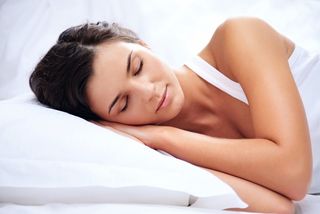This Device Records Your Snores to Track Your Sleep

A system that records the sounds of every breath and snore you utter while sleeping may offer an alternative to clinical sleep-tracking technology, new research suggests.
Researchers in Israel developed an algorithm to analyze a person's recorded breathing sounds, in order to measure sleep duration and detect sleep disorders. For example, the device could be used to diagnose people with obstructive sleep apnea, who stop breathing many times during the night, they said.
In tests, the new system was about 83 percent as accurate as the sophisticated sleep monitoring that doctors do in clinical sleep labs. However, the system is still no more accurate than commercial fitness trackers that also claim to measure sleep, scientists say.
Getting enough sleep is essential for good health, quality of life, work productivity and many other things. The gold standard for measuring sleep in a lab is polysomnography, which includes electroencephalography (EEG), to measure brain waves; echocardiography (ECG), to measure heart signals; and electromyography (EMG), to measure muscle activity.
But polysomnography is expensive, and requires a person to spend a night in a lab. This is one reason that more than 80 percent of people with sleep disorders go undiagnosed, said Yaniv Zigel, a biomedical engineer at Ben-Gurion University of the Negev in Israel who worked on the new system.
Fitness trackers offer another way to track sleep. Models such as the Fitbit Force and the Jawbone UP offer sleep tracking; these devices rely on motion sensors to track how long and how well a person sleeps. But although they give users a rough idea of how much sleep they get, these devices are not very accurate, and cannot be used to diagnose medical conditions such as sleep apnea.
The new system is designed to detect whether people are asleep or awake, based on their breathing sounds. When a person is sleeping, the muscles of the upper airway relax, which makes breathing noisier than it is when a person is awake.
Sign up for the Live Science daily newsletter now
Get the world’s most fascinating discoveries delivered straight to your inbox.
The researchers wanted to create a device that was noninvasive, Zigel said. "You can sleep naturally, undisturbed, without any sensors connected to you or your mattress," he told Live Science.
In the latest study of the system, published in February in the journal PLOS ONE, 150 people spent a night in a sleep lab, and the researchers monitored them using both the new system and traditional polysomnography sensors.

The tests showed that, for 92 percent of the time the participants were sleeping, the audio system correctly indicated they were asleep. However, the system was less effective in detecting when the participants were awake; it correctly detected wakefulness only 57 percent of the time. In other words, the system mistook waking periods for sleep nearly half of the time, according to the results.
"This was a very-high-quality study," said Hawley Montgomery-Downs, a sleep psychologist at West Virginia University who was not involved in the research. The researchers tested their system more rigorously than the manufacturers of fitness trackers that claim to measure sleep, she told Live Science.
However, the audio-based system doesn't seem to be any more accurate at tracking sleep and wakefulness than the one or two commercial systems already available that Montgomery-Downs and that other researchers have evaluated, she said. Still, the idea behind this system is worth exploring, she added.
In a previous study of people with sleep apnea who were recorded speaking words while awake, the device detected 85 percent of cases. That study was published in proceedings from an IEEE conference in 2014.
The next step will be to develop a more mobile version of the system that anyone could use at home, such as on a smartphone, Zigel said. Also, the researchers hope to adapt their system for use in a bedroom with more than one person.
Editor's Note: This story was generated during a trip paid for by American Associates, Ben-Gurion University of the Negev.
Follow Tanya Lewis on Twitter. Follow us @livescience, Facebook & Google+. Original article on Live Science.

